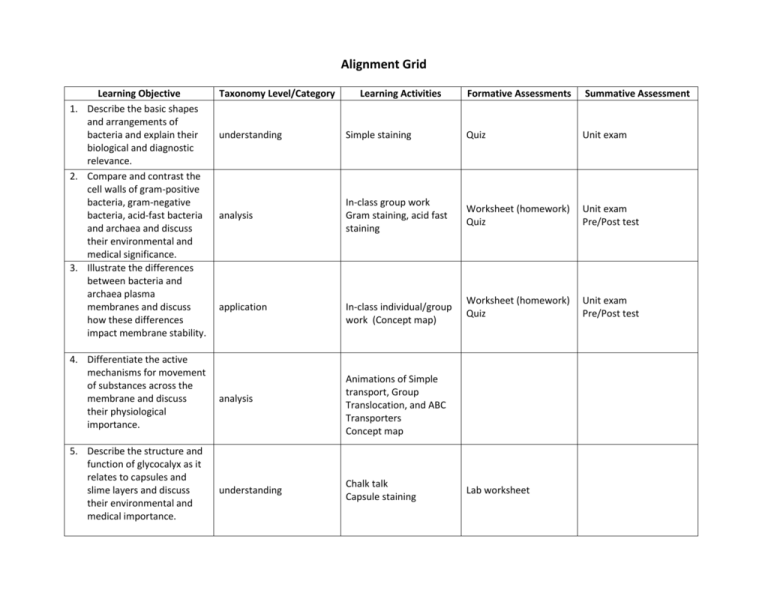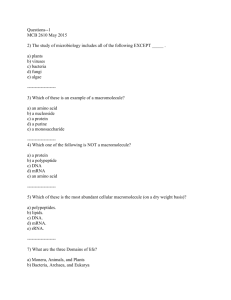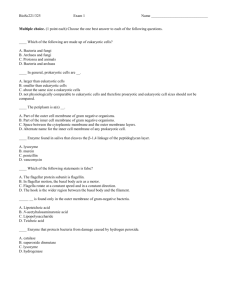2012AlignmentGrid worksheet and qiuz exam questions
advertisement

Alignment Grid Learning Objective 1. Describe the basic shapes and arrangements of bacteria and explain their biological and diagnostic relevance. 2. Compare and contrast the cell walls of gram-positive bacteria, gram-negative bacteria, acid-fast bacteria and archaea and discuss their environmental and medical significance. 3. Illustrate the differences between bacteria and archaea plasma membranes and discuss how these differences impact membrane stability. 4. Differentiate the active mechanisms for movement of substances across the membrane and discuss their physiological importance. 5. Describe the structure and function of glycocalyx as it relates to capsules and slime layers and discuss their environmental and medical importance. Taxonomy Level/Category Learning Activities Formative Assessments Summative Assessment understanding Simple staining Quiz Unit exam analysis In-class group work Gram staining, acid fast staining Worksheet (homework) Quiz Unit exam Pre/Post test Worksheet (homework) Quiz Unit exam Pre/Post test application analysis understanding In-class individual/group work (Concept map) Animations of Simple transport, Group Translocation, and ABC Transporters Concept map Chalk talk Capsule staining Lab worksheet 6. Sketch and differentiate flagella, axial filaments, fimbriae, and pili and discuss their roles in motility and attachment 7. Describe the structure and function of endospores and explain their industrial and medical importance. 8. Construct an appropriate cell structure given a particular set of environmental conditions. Spore staining synthesis/evaluation Group activities Case studies Lab worksheet Unit exam 1. Describe the basic shapes and arrangements of bacteria and explain their biological and diagnostic relevance. a) Which drawing in the figure is a streptococcus? b) Based on the figure, which one(s) would you perform a catalase test on? c) Draw a microscopic image of a staphylococcus. d) Bacterial cells that are isolated from a healthy human’s skin and appear as long chains of cocci are likely of the genus 2. Compare and contrast the cell walls of gram-positive bacteria, gram-negative bacteria, acid-fast bacteria and archaea and discuss their environmental and medical significance. a) In the above figure, which cell wall is toxic? b) Compare and contrast the cell walls of Gram + bacteria, Gram – bacteria, and Archaea. c) Negatively charged molecules that are partially responsible for the negative charge of the gram-positive bacterial cell surface are d) Which of the following cell wall components makes an acid-fast bacteria acid fast? 3. Illustrate the differences between bacteria and archaea plasma membranes and discuss how these differences impact membrane stability. a) In archaeal membranes, what serves the same function as the fatty acids of bacterial membranes? b) What is the evolutionary advantage of the monolayer often found in archaeal membranes? 4. Differentiate the active mechanisms for movement of substances across the membrane and discuss their physiological importance. a) The chemical modification that takes place during group translocation is b) The prokaryotic transport system that involves a substrate-binding protein and a membrane-integrated transporter is c) Which statement is TRUE? The phosphotransferase system is a type of group translocation. Group translocation is a part of the phosphotransferase system. The phosphotransferase system is a form of simple transport. The phosphotransferase system has nothing to do with group translocation. The ABC transport system utilizes phosphotransferase d) If you were a bacteria that requires iron for growth but are placed in an environment with extremely low free iron concentrations, which transport system would serve you the best? e) What is the energy source for the import of an inorganic ion through a simple symporter? f) Which of the following are MOST dissimilar when comparing gram-negative to gram-positive bacteria? 5. Describe the structure and function of glycocalyx as it relates to capsules and slime layers and discuss their environmental and medical importance. a) How are capsules and slime layers distinguished from one another?









